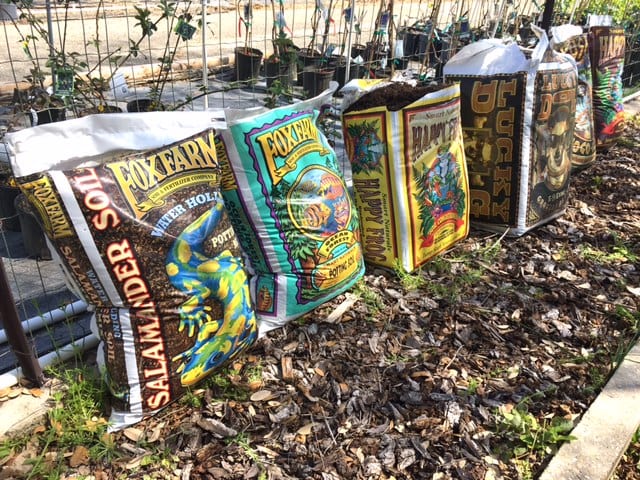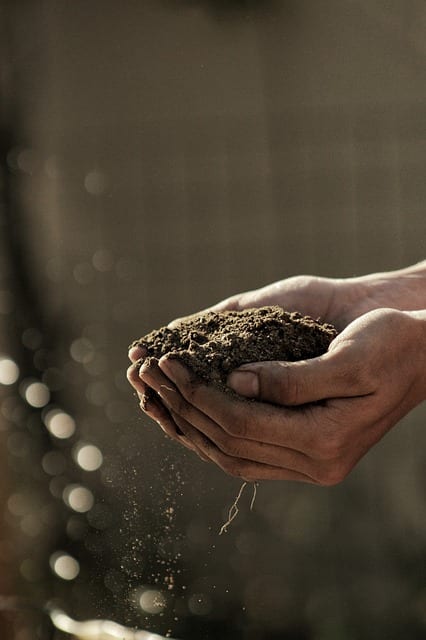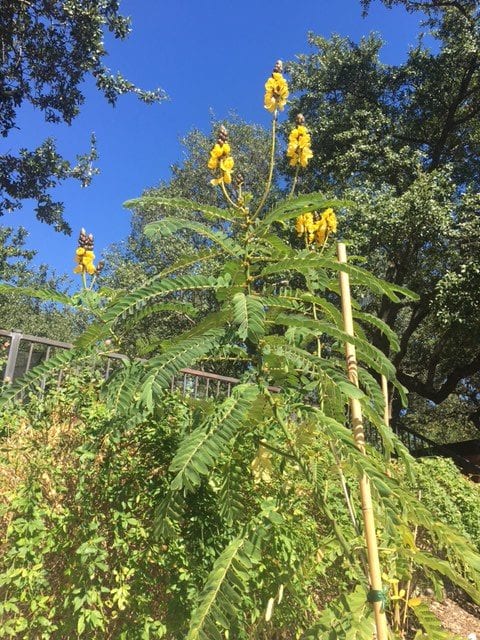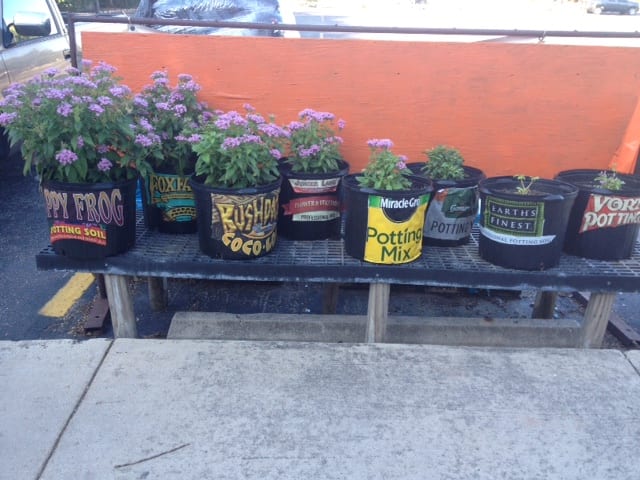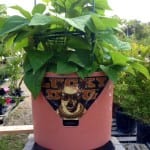I’ve done it. I’m all in. It’s taken me about 6 out of the 7 years I’ve worked at Rainbow Gardens to take the final plunge, but I’ve finally done it! I’ve gone completely organic. I really don’t know why it’s taken me this long to get there, I can only blame it on a stubborn streak that runs deep within and me and perhaps a strong desire for instant gratification as well. I guess I’ve been running a six year soil/fertilizer test, just to make sure there was no doubt. FoxFarm products helped me work it out.
We have a wide variety of organic products to choose from. Pick one, start somewhere.
Last fall til now, I’ve used only organic products in my gardens. I’ve been filling my raised beds with natural soil and amendments like FoxFarm Soil Conditioner, which is chock full of beneficial microbes and fungi (good) to encourage nutrient uptake through roots. I’ve been mixing in organic granular fertilizers to my soil and supplementing with soluble fertilizer products like FoxFarm Grow Big and FoxFarm Tiger Bloom. I’ve treated my freshly dug up transplants to Bush Doctor Kangaroots to stimulate root mass and strength in their new homes. And in return for my loyal patronage into the world of complete organic gardening, I’ve been rewarded through these past seasons with the strongest, most productive plants I’ve had since beginning my gardening endeavors.
FoxFarm goodies. Many more to choose from.
The only decision I used to make was between planting in garden soil or potting soil. The only fertilizer I used to know came in a little green box and stained my fingers blue. I didn’t know that while synthetic fertilizers do contain macronutrients ( nitrogen, phosphorous and magnesium) that are rapidly available to the plant, they could also be lacking many other important micronutrients (the secondary and trace minerals required to support plant life). I thought soil was soil, until I read the labels and only saw the worm castings, humic acid, and bat guano in my premium organic bags. Where was all that yummy stuff in the synthetic bags? The premium bags contained both macronutrients and micronutrients plus all the ‘yummies’ rolled up into one product. I thought feeding was feeding, but when it comes to synthetic versus organic feeding, there really can be a big difference. With synthetic granular fertilizers it’s easier to overfeed (ex: incorrectly measuring and supplying too much nitrogen and in turn, harming your plant rather than helping it) than it is with organic fertilizers because organic granular fertilizers are slow-release. They go through a slower process of being broken down and nutrients are steadily released to the plant rather than all at once. This means you have less chance of ‘burning up’ your plants when you choose organic.
Extra goodies listed too!
With organic fertilizers, you also have less chance of contaminating other property and water sources from chemicals that could be found in run off filled with synthetic fertilizers. I like to think I am helping out the environment in some small way, but I also selfishly love the difference in the health of my plants and the decrease in the time spent battling insects and disease. Plus, I really started to think about the process of a tiny seed being covered in soil, the plant taking up what’s in that soil, me touching the soil , me touching the plant, and then me eating the plant. Yeesh! When I got to thinking that I was essentially eating the soil and whatever fertilizer I put into it, that’s truly what made me a believer and convert.
God made dirt, so dirt don’t hurt right?
We all have our preferences when it comes to gardening products and I am obviously biased when it comes to FoxFarm; but that is because I’ve done my own tests and I’ve seen firsthand the difference and the results, and I’m sold. The proof was in my first bite of a freshly picked, warmed-by-the-sun, Blush heirloom tomato that came off my tomato plant that was still producing late in the summer. (Yes, late in the summer!) The proof was in not having to battle pesky insects since they tend not to target healthy plants. The proof was in my 10 foot tall Popcorn Plant that I grew from a tiny seed nestled into a pot filled with FoxFarm Happy Frog potting soil. No fertilizer, just the potting soil. The proof is my veggie transplants planted last week that have since strengthened and doubled their size. The proof is in the swarm of butterflies greedily slurping from the vibrant flowers on my perennials that survived our blazing summer and are thanking me for using FoxFarm Tiger Bloom. The proof will be in my fall vegetable harvest. And there will be proof again when the roots of my plants, that have been continually nourished with the organic matter built up in my soil, are strong enough to push up new growth come springtime.
The 10 foot Popcorn Plant from one tiny seed. PROOF!
Come by Rainbow Gardens and you’ll see we usually have a soil test going on each season. Take note of what each plant looks like at the time you are there. Snap a picture so you’ll have a record. Come back each month and make some comparisons. They all start out looking the same. At first, certain plants pull ahead and seemingly look like there is no doubt they’ll be at the finish line first. And yes, they will be at the finish line, but not as winners. They’ll finish alright, they’ll finish producing and finish having vibrant green foliage, and finish putting out blooms. They’ll have gobbled up all their ready to eat nutrients and won’t have anything left over for the long haul. Pretty soon, the plants in the organic material, still full of vigor and health, will pass right by them and continue past the finish line, further than you could think possible. This time, steady wins the race, not slow, but steady. Want to know the soil that continues to get a blue ribbon in this race? I’ll give you a hint….ahem…most anything from FoxFarm….. just saying! We do these soil tests at Rainbow Gardens so you can see that even just switching to a premium organic soil and adding nothing else, offers your plants a shot at being the best they can be.
From last year, but it is truly amazing proof. They all get the same care, light, water, etc… the only difference is the soil they are planted in.
Choosing any organic product is a great first step. You’ll be starting the process of building your soils and giving your plants a leg up. Choosing the BEST organic products out there is an even better step. Read the labels, search the web and do research on all the different products out there. Do your own tests if you need to, and come to Rainbow Gardens with your questions.
Put in the good stuff and you’ll get the good stuff!
The Happy Gardener,
Lisa Mulroy


